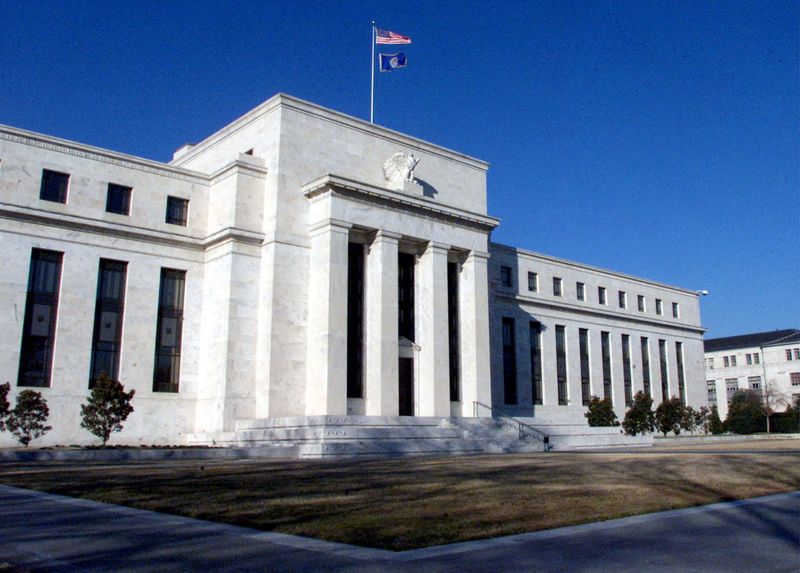Big central banks hike again with end in sight
2023.07.27 12:14

© Reuters. FILE PHOTO: The U.S. Federal Reserve building in Washington, D.C./File Photo
LONDON (Reuters) – Major central banks are nervously eyeing the end of aggressive interest rate hikes as price pressures finally show signs of easing.
Inflation remains high across the globe, but in some big economies has cooled faster than expected.
Upcoming decisions are on a knife-edge. Pausing too early could cause financial conditions to loosen too fast, re-igniting inflationary pressures. Stopping too late could put a credit crunch and a deep recession on the cards.
To date, nine developed economies have raised rates by a combined 3,840 basis points (bps) in this cycle. Japan is the holdout dove.
Here’s a look at where central banks stand, ranked in terms of how much they have hiked rates so far this cycle.
1) UNITED STATES
The Federal Reserve raised rates by 25 basis points on July 26 to a range of 5.25%-5.5%, in its 11th rate increase of its last 12 meetings.
Fed chair Jerome Powell left the door open to more hikes but the market was unconvinced, with money market pricing implying traders thought this was the last hike of this cycle.
2) NEW ZEALAND
Having raised its cash rate to a 14-year high of 5.5% in May, the Reserve Bank of New Zealand kept it there in July.
This may have marked the end of a 20-month hiking cycle. Economists polled by Reuters expect the RBNZ to stay on hold for the rest of 2023.
3) BRITAIN
The Bank of England meets on August 3. Expectations for a big rate increase have eased after latest data showed inflation fell to a softer-than-expected 7.9% in June. The BoE raised rates by 50 bps to 5% in June, their highest since 2008, sending UK mortgage rates to a 15-year high.
Still, relief inflation may have peaked means markets have pulled back earlier bets of UK rates topping 6%.
4) CANADA
The Bank of Canada hiked rates to a 22-year high of 5% on July 12. Minutes of that meeting showed policymakers had discussed delaying the rate increase, but decided they could not risk inflation rebounding.
Canada’s inflation rate fell to 2.8% in June. The BoC does not expect it to decline to its 2% target until mid-2025.
5) EURO ZONE
The European Central Bank on Thursday raised its deposit rate by 25 bps to 3.75%, the highest level since 2000.
It kept its options open on whether more increases will be needed to fight stubbornly high inflation but removed a clear hint at further hikes from its policy statement, meaning another increase at the next meeting in September should not be taken for granted.
6) AUSTRALIA
Australia’s central bank held its key rate at an 11-year high of 4.1% in July and a slow down in inflation in the second quarter has eased pressure for further hikes.
Markets price in just a one-in-four chance of another rise in August, Governor Philip Lowe’s (NYSE:) penultimate meeting at the helm before being replaced by Deputy Governor Michele Bullock in September.
7) NORWAY
Core inflation in Norway hit a fresh record of 7% in June, meaning the tightening cycle is not over yet.
The Norges Bank raised rates more than expected by 50 bps to a 15-year high of 3.75% in June and a further hike is expected in August.
8) SWEDEN
Sweden’s Riksbank is expected to keep raising rates, even with house prices 20% down since March 2022.
Inflation cooled to 6.4% in June, still far above its 2% target. Markets place an 80% chance of a 25 bp rates hike in September after the Riksbank tightened by the same amount, to 3.75%, in June.
9) SWITZERLAND
Investors are divided over whether the Swiss National Bank will raise interest rates again, after inflation cooled to 1.7% in June.
The SNB has nudged rates up to 1.75%, from -0.75% in June last year. Markets think there’s a 50% chance of a 25 bps increase in September, and an equal chance of a hold.
10) JAPAN
The Bank of Japan, the world’s most dovish major central bank, concludes a two-day meeting on Friday. All eyes are trained on whether Governor Kazuo Ueda will succumb to 15 months of above-target inflation and finally tighten policy.
The central bank is leaning towards keeping the dial set to dovish, Reuters reported last week.








